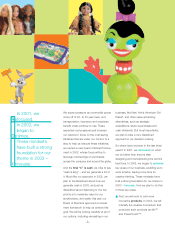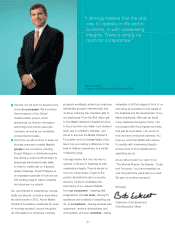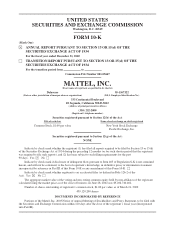Mattel 2002 Annual Report Download - page 17
Download and view the complete annual report
Please find page 17 of the 2002 Mattel annual report below. You can navigate through the pages in the report by either clicking on the pages listed below, or by using the keyword search tool below to find specific information within the annual report.In the International segment, there is also a concentration of sales to certain large customers. The customers
and the degree of concentration vary depending upon the region or nation.
Licenses and Distribution Agreements
Mattel has license agreements with third parties that permit Mattel to utilize the trademark, character, or
inventions of the licensor in product lines that Mattel manufactures. A number of these licenses relate to product
lines that are significant to Mattel’s business and operations. An important licensor is Warner Bros., which
licenses the Harry Potter™book and movie property for use on Mattel’s products as well as the master toy
license for Batman™, Superman™, Justice League™, Looney Tunes™and Baby Looney Tunes™. Mattel has also
entered into license agreements with, among others: Disney Enterprises, Inc., relating to classic Disney
characters such as Winnie the Pooh and the Disney Princesses; Sesame Workshop relating to its Sesame Street®
properties; Viacom International, Inc. relating to its Nickelodeon®properties including SpongeBob
SquarePants™and Dora the Explorer™; Nihon Ad Systems Inc. for the master toy license to the Yu-Gi-Oh!™
property worldwide, excluding Asia; and Lyons Partnership, L.P. relating to Barney™, the purple dinosaur, as
well as Barney™for Baby, for infant and preschool toys, feature plush, electronic learning aids, games and
puzzles.
Royalty expense during 2002, 2001 and 2000 was approximately $210 million, $220 million and
$259 million, respectively. See “Product Design and Development” and Item 8 “Financial Statements and
Supplementary Data—Note 9 to the Consolidated Financial Statements.”
Mattel also licenses a number of its trademarks, characters and other property rights to others for use in
connection with the sale of non-toy products that do not compete with Mattel’s products. Mattel distributes some
third party finished products that are independently designed and manufactured.
Trademarks, Copyrights, and Patents
Most of Mattel’s products are sold under trademarks, trade names and copyrights and a number of those
products incorporate patented devices or designs. Trade names and trademarks are significant assets of Mattel in
that they provide product recognition and acceptance worldwide.
Mattel customarily seeks patent, trademark or copyright protection covering its products, and it owns or has
applications pending for US and foreign patents covering many of its products. A number of these trademarks
and copyrights relate to product lines that are significant to Mattel’s business and operations. Mattel believes its
rights to these properties are adequately protected, but there can be no assurance that its rights can be
successfully asserted in the future or will not be invalidated, circumvented or challenged.
Commitments
In the normal course of business, Mattel enters into contractual arrangements for future purchases of goods
and services to ensure availability and timely delivery, and to obtain and protect Mattel’s right to create and
market certain products. Certain of these commitments routinely contain provisions for guaranteed or minimum
expenditures during the term of the contracts. Current and future commitments for guaranteed payments reflect
Mattel’s focus on expanding its product lines through alliances with businesses in other industries.
As of December 31, 2002, Mattel had outstanding commitments for 2003 and 2004 purchases of inventory
of approximately $103 million. Licensing and similar agreements with terms extending through 2010 contain
provisions for future guaranteed minimum payments aggregating approximately $369 million. See Item 7
“Management’s Discussion and Analysis of Financial Condition and Results of Operations—Commitments” and
Item 8 “Financial Statements and Supplementary Data—Note 9 to the Consolidated Financial Statements.”
8
























